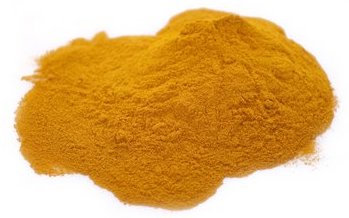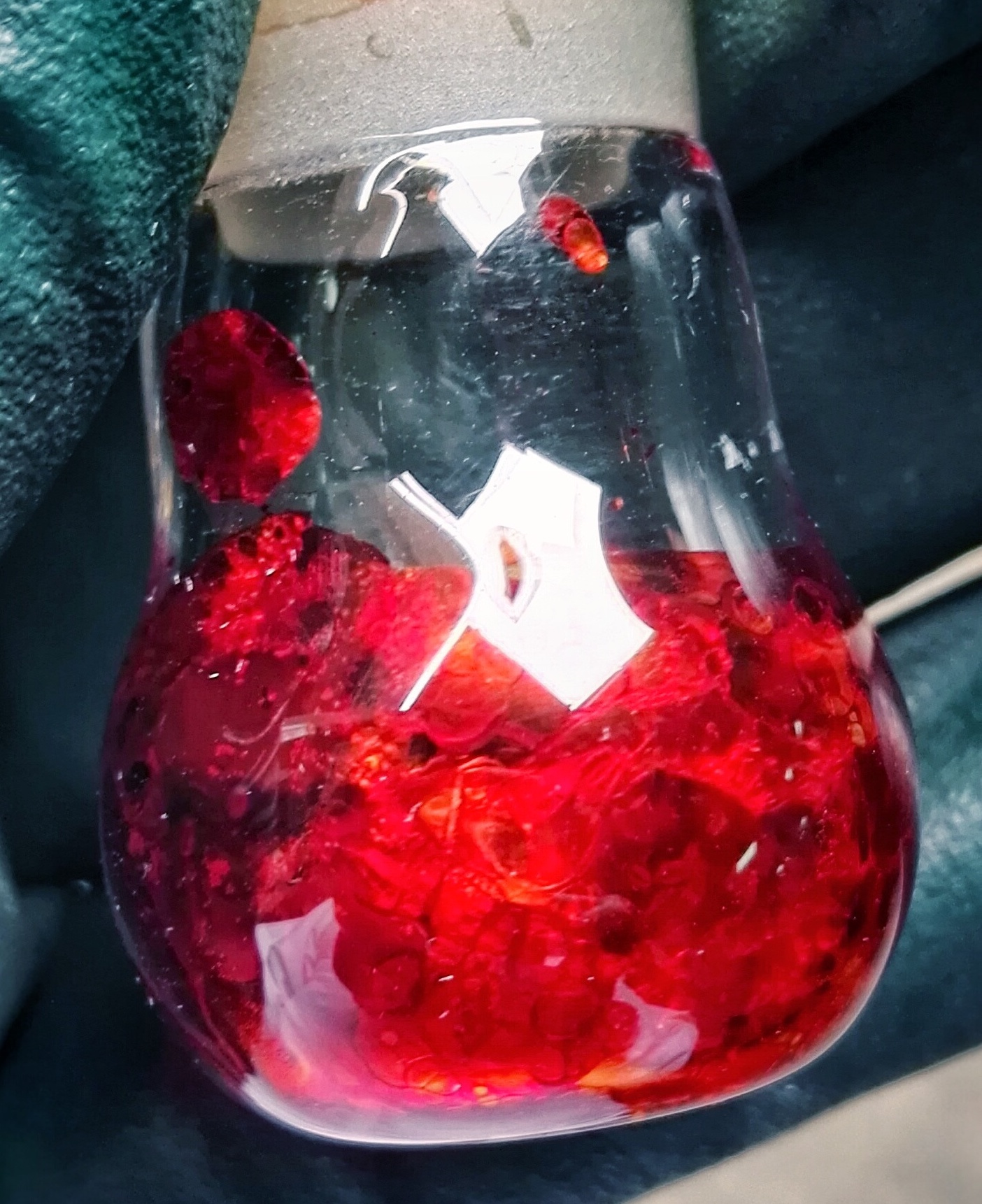|
Curcuminoid
A curcuminoid is a linear diarylheptanoid, a relatively small class of plant secondary metabolites that includes curcumin, demethoxycurcumin, and bisdemethoxycurcumin, all isolated from turmeric (curcuma longa). These compounds are natural phenols and produce a pronounced yellow color that is often used to color foods and medicines. Curcumin is obtained from the root of turmeric. Curcuminoids are soluble in dimethyl sulfoxide (DMSO), acetone and ethanol, but are poorly soluble in lipids. It is possible to increase curcuminoid solubility in aqueous phase with surfactants or co-surfactants. Most common derivatives have different substituents on the phenyl groups. There is an increasing demand for demethoxycurcumin, bisdemethoxycurcumin, and other curcuminoids because of their biological activity. Cyclodextrins Curcuminoids form a more stable complex with solutions which contain cyclodextrin towards hydrolytic degradations. The stability differs between size and characteriz ... [...More Info...] [...Related Items...] OR: [Wikipedia] [Google] [Baidu] |
Curcumin Structure (keto)
Curcumin is a bright yellow chemical produced by plants of the ''Curcuma longa'' species. It is the principal curcuminoid of turmeric (''Curcuma longa''), a member of the ginger family, Zingiberaceae. It is sold as a herbal supplement, cosmetics ingredient, food flavoring, and food coloring. Chemically, curcumin is a diarylheptanoid, belonging to the group of curcuminoids, which are phenolic pigments responsible for the yellow color of turmeric. Laboratory and clinical research have not confirmed any medical use for curcumin. It is difficult to study because it is both unstable and poorly bioavailable. It is unlikely to produce useful leads for drug development. History Curcumin was named in 1815 when Henri Auguste Vogel and Pierre Joseph Pelletier reported the first isolation of a "yellow coloring-matter" from the rhizomes of turmeric. Later, it was found to be a mixture of resin and turmeric oil. In 1910, Milobedzka and Lampe reported the chemical structure of curcumin t ... [...More Info...] [...Related Items...] OR: [Wikipedia] [Google] [Baidu] |
Curcumin
Curcumin is a bright yellow chemical produced by plants of the ''Curcuma longa'' species. It is the principal curcuminoid of turmeric (''Curcuma longa''), a member of the ginger family, Zingiberaceae. It is sold as a herbal supplement, cosmetics ingredient, food flavoring, and food coloring. Chemically, curcumin is a diarylheptanoid, belonging to the group of curcuminoids, which are phenolic pigments responsible for the yellow color of turmeric. Laboratory and clinical research have not confirmed any medical use for curcumin. It is difficult to study because it is both unstable and poorly bioavailable. It is unlikely to produce useful leads for drug development. History Curcumin was named in 1815 when Henri Auguste Vogel and Pierre Joseph Pelletier reported the first isolation of a "yellow coloring-matter" from the rhizomes of turmeric. Later, it was found to be a mixture of resin and turmeric oil. In 1910, Milobedzka and Lampe reported the chemical structure of ... [...More Info...] [...Related Items...] OR: [Wikipedia] [Google] [Baidu] |
Turmeric
Turmeric () is a flowering plant, ''Curcuma longa'' (), of the ginger family, Zingiberaceae, the rhizomes of which are used in cooking. The plant is a perennial, rhizomatous, herbaceous plant native to the Indian subcontinent and Southeast Asia that requires temperatures between and a considerable amount of annual rainfall to thrive. Plants are gathered each year for their rhizomes, some for propagation in the following season and some for consumption. The rhizomes are used fresh or boiled in water and dried, after which they are ground into a deep orange-yellow powder commonly used as a coloring and flavoring agent in many Asian cuisines, especially for curries, as well as for dyeing, characteristics imparted by the principal turmeric constituent, curcumin. Turmeric powder has a warm, bitter, black pepper-like flavor and earthy, mustard-like aroma. Curcumin, a bright yellow chemical produced by the turmeric plant, is approved as a food additive by the World Hea ... [...More Info...] [...Related Items...] OR: [Wikipedia] [Google] [Baidu] |
Bisdemethoxycurcumin
Bisdemethoxycurcumin is a curcuminoid found (along with the curcuminoids curcumin and demethoxycurcumin) in turmeric (''Curcuma longa''), but absent in Javanese turmeric (''Curcuma xanthorrhiza''). Bisdemethoxycurcumin is used as a pigment and nutraceutical with antimutagenic properties. All three of the curcuminoids found in Curcuma longa have been shown to have antioxidant properties, but bisdemethoxycurcumin is more resistant than the others to alkaline degradation. It was found to be effective in sensitizing PC cells resistance against gemcitabine. See also * Curcumin Curcumin is a bright yellow chemical produced by plants of the ''Curcuma longa'' species. It is the principal curcuminoid of turmeric (''Curcuma longa''), a member of the ginger family, Zingiberaceae. It is sold as a herbal supplement, cos ... * Desmethoxycurcumin References External links * Curcuminoids Food colorings Phenolic dietary antioxidants Vinylogous carboxylic acids {{ar ... [...More Info...] [...Related Items...] OR: [Wikipedia] [Google] [Baidu] |
Demethoxycurcumin
Desmethoxycurcumin is a curcuminoid found in turmeric. Commercial grade curcumin contains a mixture of curcuminoids (desmethoxycurcumin 10–20%, bisdesmethoxycurcumin 5% or less). See also * Bis-desmethoxycurcumin Bisdemethoxycurcumin is a curcuminoid found (along with the curcuminoids curcumin and demethoxycurcumin) in turmeric (''Curcuma longa''), but absent in Javanese turmeric (''Curcuma xanthorrhiza''). Bisdemethoxycurcumin is used as a pigment and n ... * Curcumin References Curcuminoids Food colorings Phenol antioxidants Vinylogous carboxylic acids {{aromatic-stub ... [...More Info...] [...Related Items...] OR: [Wikipedia] [Google] [Baidu] |
Bisdemethoxycurcumin
Bisdemethoxycurcumin is a curcuminoid found (along with the curcuminoids curcumin and demethoxycurcumin) in turmeric (''Curcuma longa''), but absent in Javanese turmeric (''Curcuma xanthorrhiza''). Bisdemethoxycurcumin is used as a pigment and nutraceutical with antimutagenic properties. All three of the curcuminoids found in Curcuma longa have been shown to have antioxidant properties, but bisdemethoxycurcumin is more resistant than the others to alkaline degradation. It was found to be effective in sensitizing PC cells resistance against gemcitabine. See also * Curcumin Curcumin is a bright yellow chemical produced by plants of the ''Curcuma longa'' species. It is the principal curcuminoid of turmeric (''Curcuma longa''), a member of the ginger family, Zingiberaceae. It is sold as a herbal supplement, cos ... * Desmethoxycurcumin References External links * Curcuminoids Food colorings Phenolic dietary antioxidants Vinylogous carboxylic acids {{ar ... [...More Info...] [...Related Items...] OR: [Wikipedia] [Google] [Baidu] |
Turmeric
Turmeric () is a flowering plant, ''Curcuma longa'' (), of the ginger family, Zingiberaceae, the rhizomes of which are used in cooking. The plant is a perennial, rhizomatous, herbaceous plant native to the Indian subcontinent and Southeast Asia that requires temperatures between and a considerable amount of annual rainfall to thrive. Plants are gathered each year for their rhizomes, some for propagation in the following season and some for consumption. The rhizomes are used fresh or boiled in water and dried, after which they are ground into a deep orange-yellow powder commonly used as a coloring and flavoring agent in many Asian cuisines, especially for curries, as well as for dyeing, characteristics imparted by the principal turmeric constituent, curcumin. Turmeric powder has a warm, bitter, black pepper-like flavor and earthy, mustard-like aroma. Curcumin, a bright yellow chemical produced by the turmeric plant, is approved as a food additive by the World Hea ... [...More Info...] [...Related Items...] OR: [Wikipedia] [Google] [Baidu] |
Demethoxycurcumin
Desmethoxycurcumin is a curcuminoid found in turmeric. Commercial grade curcumin contains a mixture of curcuminoids (desmethoxycurcumin 10–20%, bisdesmethoxycurcumin 5% or less). See also * Bis-desmethoxycurcumin Bisdemethoxycurcumin is a curcuminoid found (along with the curcuminoids curcumin and demethoxycurcumin) in turmeric (''Curcuma longa''), but absent in Javanese turmeric (''Curcuma xanthorrhiza''). Bisdemethoxycurcumin is used as a pigment and n ... * Curcumin References Curcuminoids Food colorings Phenol antioxidants Vinylogous carboxylic acids {{aromatic-stub ... [...More Info...] [...Related Items...] OR: [Wikipedia] [Google] [Baidu] |
Diarylheptanoid
The diarylheptanoids (also known as diphenylheptanoids) are a relatively small class of plant secondary metabolites. Diarylheptanoids consist of two aromatic rings (aryl groups) joined by a seven carbons chain (heptane) and having various substituents. They can be classified into linear (curcuminoids) and cyclic diarylheptanoids. The best known member is curcumin, which is isolated from turmeric (''Curcuma longa'') and is known as food coloring E100. Some other ''Curcuma'' species, such as '' Curcuma comosa'' also produce diarylheptanoids. They have been reported from plants in 10 different families, e.g. ''Betulaceae'' and ''Zingiberaceae''. A diarylheptanoid is an intermediate in the biosynthesis of phenylphenalenones in '' Anigozanthos preissii'' or '' Wachendorfia thyrsiflora'' (Haemodoraceae). Cyclic diarylheptanoids Cyclic diarylheptanoids formed from myricanone can be isolated from the bark of ''Myrica rubra'' (Myricaceae). Two cyclic diarylheptanoids, named ostryopsi ... [...More Info...] [...Related Items...] OR: [Wikipedia] [Google] [Baidu] |
Biological Activity
In pharmacology, biological activity or pharmacological activity describes the beneficial or adverse effects of a drug on living matter. When a drug is a complex chemical mixture, this activity is exerted by the substance's active ingredient or pharmacophore but can be modified by the other constituents. Among the various properties of chemical compounds, pharmacological/biological activity plays a crucial role since it suggests uses of the compounds in the medical applications. However, chemical compounds may show some adverse and toxic effects which may prevent their use in medical practice. Activity is generally dosage-dependent. Further, it is common to have effects ranging from beneficial to adverse for one substance when going from low to high doses. Activity depends critically on fulfillment of the ADME criteria. To be an effective drug, a compound not only must be active against a target, but also possess the appropriate ADME (Absorption, Distribution, Metabolism, and ... [...More Info...] [...Related Items...] OR: [Wikipedia] [Google] [Baidu] |
Coordination Complex
A coordination complex consists of a central atom or ion, which is usually metallic and is called the ''coordination centre'', and a surrounding array of bound molecules or ions, that are in turn known as ''ligands'' or complexing agents. Many metal-containing compounds, especially those that include transition metals (elements like titanium that belong to the Periodic Table's d-block), are coordination complexes. Nomenclature and terminology Coordination complexes are so pervasive that their structures and reactions are described in many ways, sometimes confusingly. The atom within a ligand that is bonded to the central metal atom or ion is called the donor atom. In a typical complex, a metal ion is bonded to several donor atoms, which can be the same or different. A polydentate (multiple bonded) ligand is a molecule or ion that bonds to the central atom through several of the ligand's atoms; ligands with 2, 3, 4 or even 6 bonds to the central atom are common. These compl ... [...More Info...] [...Related Items...] OR: [Wikipedia] [Google] [Baidu] |
Cyclodextrin
Cyclodextrins are a family of cyclic oligosaccharides, consisting of a macrocyclic ring of glucose subunits joined by α-1,4 glycosidic bonds. Cyclodextrins are produced from starch by enzymatic conversion. They are used in food, pharmaceutical, drug delivery, and chemical industries, as well as agriculture and environmental engineering. Cyclodextrins are composed of 5 or more α-D-glucopyranoside units linked 1->4, as in amylose (a fragment of starch). Typical cyclodextrins contain a number of glucose monomers ranging from six to eight units in a ring, creating a cone shape: * α (alpha)-cyclodextrin: 6 glucose subunits * β (beta)-cyclodextrin: 7 glucose subunits * γ (gamma)-cyclodextrin: 8 glucose subunits The largest well-characterized cyclodextrin contains 32 1,4-anhydroglucopyranoside units. Poorly-characterized mixtures, containing at least 150-membered cyclic oligosaccharides are also known. Applications Drug delivery Cyclodextrins are ingredients in more than ... [...More Info...] [...Related Items...] OR: [Wikipedia] [Google] [Baidu] |



